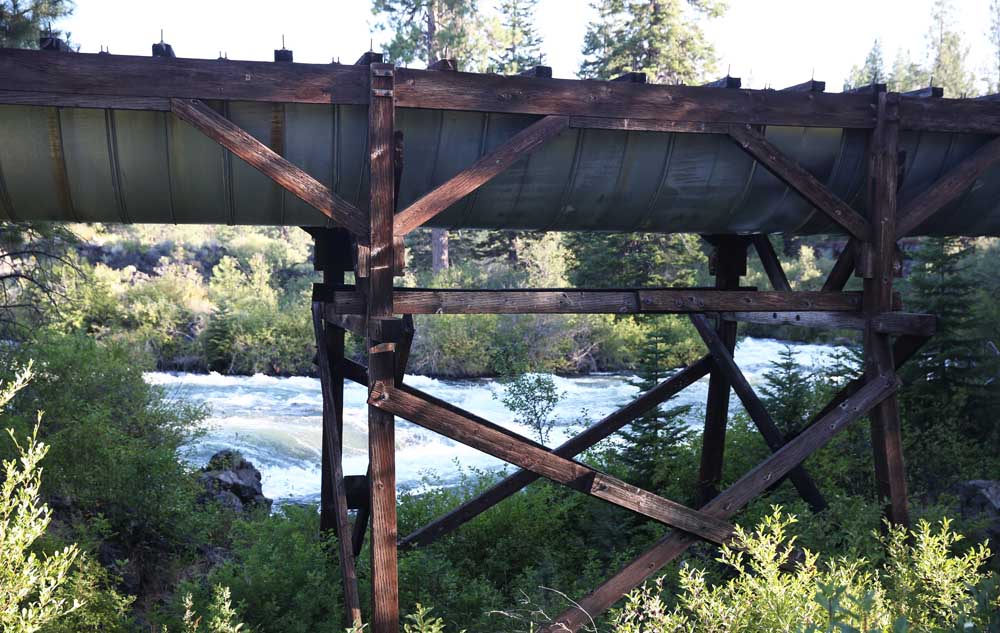Guest column: Irrigation districts are leading efforts to help water in the Deschutes Basin
Published 9:00 pm Monday, December 25, 2023

- The Arnold Irrigation District flume near Lava Island Falls on the Deschutes River in 2020.
As a community, we recently achieved a significant milestone in our ongoing efforts to address water management challenges in the Deschutes Basin. The recent approval of $12 million in grants by the Oregon Water Resources Commission for canal piping and related projects has ignited discussions.
Certain community members are attempting to divert attention from the positive advancements specifically linked to improving the environment and securing water supplies in the Deschutes Basin. These critics consistently target the eight irrigation districts at the forefront of progress, serving over 7,600 families and organizations throughout the basin. Ironically, these individuals have persistently doubted and dismissed the districts’ capacity to secure funding for large-scale modernization projects.
Despite skepticism, the districts have secured over $53 million to improve water reliability and enhance fish and wildlife habitat in Central Oregon, conserving over 49 cubic feet per second annually which is equivalent to over 7 billion gallons. These districts actively lead collaborative initiatives that unite farmers, ranchers, landowners, tribes, and conservation groups. They aim to improve the environment, safeguard water supplies, and strengthen the region’s economy and lifestyle.
This collective effort resulted in the Deschutes Habitat Conservation Plan, unlocking substantial investments for basin infrastructure modernization. This collaborative spirit is crucial for drought relief, voluntary water right transfers, and larger-scale water management projects benefiting farmers, ranchers, and fish and wildlife conservation.
Efforts to enhance the basin have been underway for decades. Since 2000, the districts, with its partners, have notably increased instream flows by nearly 80,000 acre-feet in crucial waterways like the Deschutes River, Little Deschutes River, Crooked River, Ochoco Creek, Whychus Creek, Tumalo Creek, and Crescent Creek. These efforts have been particularly beneficial for species such as salmon, steelhead, bull trout, the Oregon spotted frog, and others.
Criticism has been directed at the perceived financial burden on taxpayers, but it’s essential to dispel misconceptions. The tax dollars allocated for these projects have been appropriated from federal and state budgets, serving as a clear indication of our congresspeople and senators’ recognition of the critical importance of these initiatives. Instead of viewing it as a burden, our community should celebrate the irrigation districts’ success in securing these funds for our region. It’s noteworthy that, as taxpayers, we were already contributing, and it’s indeed gratifying that Central Oregonians will benefit directly rather than seeing these funds allocated out-of-state.
The total cost of $83 million is substantial, but it represents an investment in the long-term sustainability of our environment, agriculture industry, and the outdoor lifestyle that defines Central Oregon. Our region’s economy is intricately linked to the health of our natural resources. How can anyone put a price tag on improving the environment and preserving the place we all love to call home?
Beyond the opportunity to conserve billions of gallons of water annually, upcoming modernization projects promise a substantial economic boost for our communities. These projects are poised to contribute an estimated $219.9 million in regional economic development and support over 4,900 jobs in Central Oregon.
This investment is a commitment to community well-being, environmental preservation, and enhanced quality of life for future generations. Modernization projects safeguard the essence of Central Oregon, with visible positive impacts—water returned instream and ongoing conservation efforts.
To keyboard critics, we invite you to join us in implementing solutions. Water management challenges demand a collective effort, and positive outcomes are already evident. Let’s celebrate progress and recognize the projects’ importance in shaping a sustainable and vibrant future for Central Oregon.



